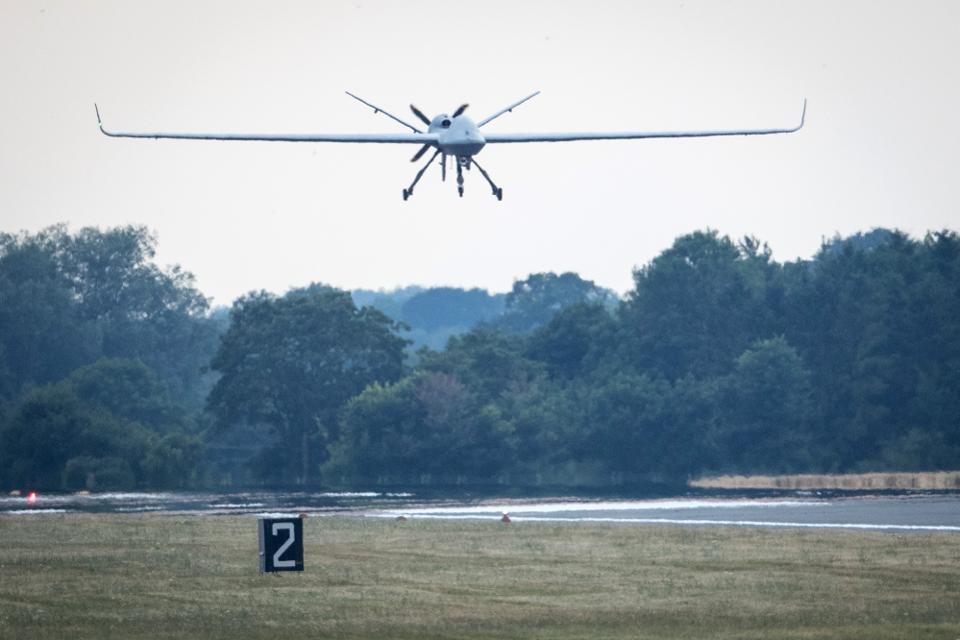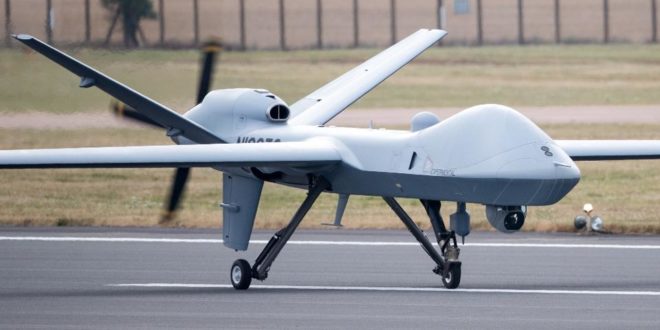A new version of the Predator drone will take off over San Diego sometime in the next few weeks, one designed to operate in civilian airspace. It might be in the air right now; authorities are not saying when the test flights will take place. The secrecy around flights of large military drones over the U.S., and their use for surveillance, is causing concern among civil rights groups.
Such concerns were highlighted when a Predator drone was spotted over Minneapolis during protests that turned violent in May. The drone was later confirmed as one of the U.S. Customs and Border Patrol Predators. These normally operates over the Canadian border but this one was reassigned to assist the local police. Member of Congress expressed “deep and profound concerns” over this action and are seeking explanations from the DHS.
FAIRFORD, ENGLAND – JULY 11: A general Atomics Aeronautical Systems Inc SkyGuardian remotely … [+]
Such uses are currently rare because FAA safety regulations restrict drone flights in civil airspace. In particular, drones lack a pilot on board who can see and avoid other aircraft, so flight plans have to be carefully arranged and a waiver granted for each flight.
General Atomics Aeronautical Systems makes the Predator and larger Predator-B, better known as the MQ-9B Reaper in military service. The new version has the more reassuring name of SkyGuardian and has an advanced detect-and-avoid system to fly safely in civil airspace. This system includes a new Due Regard Radar, able to detect other aircraft and with the same field of view as a pilot, a Traffic alert and Collision Avoidance System detecting nearby aircraft transponders, and Automatic Dependent Surveillance-Broadcast which continually broadcasts the drone’s location.
After five years of development and testing, General Atomics is hoping to move toward FAA certification with the trial flights over San Diego. Certification would open the way for routine use of such drones for watching over protests and other law enforcement and public order use, replacing the traditional police helicopters with far more powerful capabilities.
“Predators have long loiter times, all weather surveillance functions, and much higher resolution video camera optics, “ says Robert Bunker of the USC Price Safe Communities Institute. “Given the high altitudes they operate in, they are stealthy and immune to the ground-to-air hazards police helicopters would face.”
The AN/AAS-52 Multi-Spectral Targeting System carried by military Reapers comprises an array of cameras on stabilized gimbal mounts to keep them locked on the target regardless of the motion of the drone. Visible-light cameras for daytime use and image-intensified night cameras are supplemented with thermal imaging. Advanced software to combines all the camera views into single image. One camera has a x200 zoom range, equivalent to a 12,000mm lens on a consumer DSLR camera for close-up views (for example for facial recognition) from long range. Even when it is high enough to be inaudible, Predator can keep a close eye on people below, through smoke, haze, and complete darkness.

FAIRFORD, ENGLAND – JULY 11: A general Atomics Aeronautical Systems Inc SkyGuardian remotely … [+]
While most Reaper missions observe a building or follow a vehicle or individual, they can watch over much wide areas. Systems like the all-seeing Gorgon Stare can watch over an entire city at once with an array of cameras, following everything occurring across six square miles simultaneously. The advantage of this type of wide-area motion imagery is that it can record and ‘rewind’: track a person of interest back through time and see where they have been and who they have been in contact with, then tracing those contacts back and forward in time in turn.
In addition, military Reapers carry equipment to track, locate and monitor cellphone and other radio communications. According to one source from 2014, more drone strikes were carried out targeting the location of a SIM card associated with a targeted individual than by visual identification, suggesting this is a key feature of their operations.
And with SkyGuardian’s 40-hour endurance, operators will be able to watch a lot of people over an extended period, without them even knowing they are under observation. If used for civil surveillance they would probably carry new equipment specially designed for the role which might include new types of sensor.
Of course, this type of capability comes at a price.
“This is well beyond normal law enforcement resources and budgets,” says Bunker. SkyGuardians would likely be acquired by federal agencies but, as at Minneapolis, might be made available to local police if requested.
Barry Summers, an anti-drone activist living in North Carolina, has been following the migration of military drones to civil airspace this six years. Summers notes that all six states with FAA drone integration programs have selected former military officers to run them. This makes sense, as they are the ones with practical experience, but Summers believes they are quietly pursuing a Pentagon vision of drone operation over the U.S.
“The integration of large military surveillance drones into civilian airspace is happening with little public awareness or debate,” says Summers.
General Atomics has said that they were working with city officials, a claim later disputed by the mayor’s spokesman. The FAA declined to provide any information of the planned trials, telling The Voice of San Diego newspaper, “We can’t get into details about a military aircraft program.” The paper is attempting to get the information via the FOIA and by suing the FAA to find out when the flights will take place.
The latest version of the national plan to integrate drones into civilian airspace indicates that flight demonstrations need to be completed by August, so this month is crucial. The two pages of the report dealing with risks (page 20 and 30) have been redacted. Given the Reaper’s accident record, Summers and others have expressed concern over the danger that a SkyGuardian with its 79-foot wingspan could crash in San Diego.
If the flights are successful and FAA certification goes ahead as planned, then it will be a green light for SkyGuardian as a means of civilian surveillance. That will be good news for General Atomics, which has seen Reaper production abruptly terminated as the U.S. Air Force looks for lower-cost options. They have already sold SkyGuardian to the U.K., but operations over the U.S. would open up a huge potential new market. would, however, heighten existing concerns.
“Predators are traditionally used outside the contiguous United States and tasked for surveillance and the targeted elimination of designated foreign terrorists as well as for monitoring our southern border,” says Bunker. “Deploying such drones domestically blurs the line between such external military conflict environments and internal domestic policing ones.”
And while U.S. citizens routinely hand over vast quantities of highly personal data to tech firms like Google
“It should raise immediate constitutional red flags concerning individual American liberties vis-à-vis internal securitization and the increasing coercive police state narrative under the Trump presidential administration,” says Bunker.
 Unmanned Aerial Vehicle The latest drone news
Unmanned Aerial Vehicle The latest drone news




